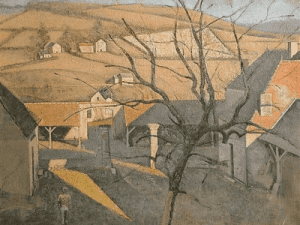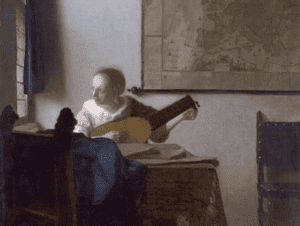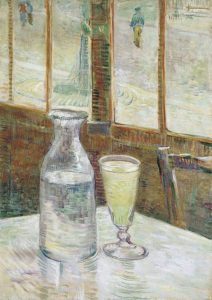(Skip to bullet points (best for students))

Born: 1887
Died: 1986
Summary of Georgia O’Keeffe
Georgia O’Keeffe was a major figure in the development of American modernism and its link to early twentieth-century European avant-garde groups. Over the course of seven decades, she created a large body of work in which she attempted to abstract the natural world in order to convey the emotion and force of things. Her paintings of flowers, desolate landscapes, and close-up still lifes have become part of the mythology and iconography of the American aesthetic landscape, according to Alfred Stieglitz, who recognised her as the first female American modernist.
O’Keeffe utilised other artists’ methods, and was particularly impressed by Paul Strand’s use of cropping in his pictures; she was one of the first painters to apply the technique to painting, creating close-ups of distinctly American things that were extremely detailed but abstract.
O’Keeffe did not belong to any one artistic trend, yet she, like Arthur Dove, experimented with abstracting natural elements. She worked in series, combining abstraction and realism to create pieces that focused on nature’s basic forms. While some of these pieces are very detailed, others have been stripped of what she deems unnecessary in order to focus on shape and colour.
O’Keeffe’s art remained grounded in depiction while pushing its limitations via intensive study of nature, size experimentation, and subtle use of line and colour. O’Keeffe’s art was out of the mainstream from the 1940s through the 1960s, since she was one of the few painters to stick to representation at a time when others were experimenting with non-representation or abandoning painting completely.
Childhood
Georgia O’Keeffe was born in 1887, the second of seven children, near Sun Prairie, Wisconsin. Her mother encouraged her to pursue art at a young age, and she took watercolour classes from Sara Mann, a local artist. O’Keeffe was from a family that valued education for women, and she was fortunate enough to study with John Vanderpoel at the School of the Art Institute of Chicago from 1905 to 1906.
Early Life
O’Keeffe travelled to New York City in the fall of 1907 and enrolled at the Art Students League, where she studied under artist-teacher William Merritt Chase. She was able to attend the League’s summer school at Lake George, New York, thanks to a prize she received for one of her still lifes. She went to a lot of shows at Gallery 291, which was owned by photographer Alfred Stieglitz and was one of the few venues in the US where European avant-garde art was shown. O’Keeffe was introduced to well-known European painters such as Auguste Rodin and Henri Matisse for the first time.
In 1908, she took a work as a commercial artist in Chicago, abandoning her painting profession for four years.
In 1912, she returned to her painting after taking a drawing class at the University of Virginia’s summer school. Alon Bement, her instructor, was known for his unique teaching methods, which were greatly influenced by the artist Arthur Wesley Dow. O’Keeffe began experimenting with Dow’s notion of self-exploration through painting while teaching at Columbia College in South Carolina in 1915.
She created a small series of charcoal drawings that reduced natural objects like ferns, clouds, and waves into expressive, abstracted combinations of shapes and lines. After completing this series, O’Keeffe submitted a couple of them to an old classmate, Anita Pollitzer, who brought the drawings to Alfred Stieglitz’s notice in January 1916.
Mid Life
Stieglitz began corresponding with O’Keeffe after recognising her potential. He displayed 10 of her charcoals at his Gallery 291, unbeknownst to O’Keeffe. He began their working connection by sending her photos of her artwork on display. While continuing to teach, O’Keeffe visited New York in 1917 to see her first solo show, which was organised by Stieglitz at 291. O’Keeffe and Stieglitz began a love affair at this period that would endure until his death. Stieglitz promised to financially assist O’Keeffe for a year in order for her to reside and paint in New York in 1918.
During the 1920s, Stieglitz introduced O’Keeffe to his friends and fellow artists, including Marsden Hartley, Arthur Dove, John Marin, and Paul Strand, who formed the Stieglitz Circle. In the United States, Stieglitz and his Circle, as they were known, championed modernism. Strand’s photography and the camera’s capacity to act as a magnifying lens, as well as Charles Sheeler’s Precisionism, had a huge effect on O’Keeffe. Following these interests, she began creating large-scale close-up paintings of natural forms, switching from watercolours to oil paint at the same time. O’Keeffe painted New York skyscrapers and other architectural elements in addition to flowers.
O’Keeffe’s interest with the environment of New Mexico began in 1929, when she visited Mabel Dodge Luhan’s estate near Taos as a guest of the famed arts patron. O’Keeffe grew fascinated with New Mexico’s views and desolate countryside, returning to paint there every summer until 1949. The grandeur of the desert, its huge sky, peculiar architectural shapes, and bones she found in the desert were captured in the works created from this setting. O’Keeffe’s subsequent acquisition of two homes in New Mexico solidified her links to the region.
During the 1930s and 1940s, O’Keeffe’s fame grew, and she had two major retrospectives, the first in 1943 at the Art Institute of Chicago and the second in 1946 at the Museum of Modern Art, the latter being the museum’s first retrospective of work by a woman.
Late Life
O’Keeffe went to New Mexico permanently in 1949, three years after Stieglitz’s death. She created a series of paintings in the 1950s that emphasised the architectural features of her patio wall and door in Abiquiu, one of her two residences near Santa Fe. O’Keeffe began travelling widely in order to acquire ideas for her work. She was inducted into the American Academy of Arts and Letters and was awarded the Medal of Freedom and the National Medal of Arts. Despite her declining popularity in the 1950s and 1960s, a Whitney Museum of American Art exhibition in 1970 resurrected her career and brought her to the notice of a new generation of women during the feminist period.
Despite her deteriorating eyesight, O’Keeffe continued to create art in the 1970s, working in watercolour, pencil, and clay. She continued to paint even though she had lost her centre vision at the age of 84. Her most recent works feature basic abstract lines and forms that recall her early charcoal drawings.
Famous Art by Georgia O’Keeffe
Blue #2
1916

Blue II is reminiscent of O’Keeffe’s early monochrome sketches and watercolours, which use abstract shapes to suggest the flow of nature. While the curvilinear form in Blue II resembles a plant, O’Keeffe was playing the violin at the time, and the shape most likely represents the scroll-shaped end of the violin’s neck, which would have been in O’Keeffe’s line of sight while she played. She may have been aware with Wassily Kandinsky’s idea that visual art, like music, should express emotion via the use of colour and line, as seen by the vivid blue colour. The deep blue may allude to the music’s tone and the atmosphere it inspires or portrays.
Cow’s Skull: Red, White and Blue
1931

After visiting New Mexico, O’Keeffe got fascinated with animal skulls. O’Keeffe depicts the fundamental essence of the skull while simultaneously emphasising the transience of life through the exact portrayal of the worn skull’s surface and sharp edges. O’Keeffe utilises the cow’s skull and the red, white, and blue backdrop to signify both naturalism and nationalism, or the link between the American landscape and national identity, isolated on the painting and separated from its desert environment. Furthermore, the theme might make an environmental and economic statement by alluding to the Dust Bowl and the Great Depression.
Sky above Clouds, IV
1965

The series Sky above Clouds is no exception, since the painting relates to O’Keeffe’s various trips between the 1950s and 1960s. She became fascinated by the view of the clouds below the plane while en way to the Far East and attempted to paint this aerial vista as though to reflect her own broadened view of the globe. She began stretching large canvases, about 24 feet wide, to depict the expansiveness of the vista, despite the fact that she was nearly 80 years old at the time.
BULLET POINTED (SUMMARISED)
Best for Students and a Huge Time Saver
- Georgia O’Keeffe was a major figure in the development of American modernism and its link to early twentieth-century European avant-garde groups.
- Over the course of seven decades, she created a large body of work in which she attempted to abstract the natural world in order to convey the emotion and force of things.
- Her paintings of flowers, desolate landscapes, and close-up still lifes have become part of the mythology and iconography of the American aesthetic landscape, according to Alfred Stieglitz, who recognised her as the first female American modernist.
- O’Keeffe utilised other artists’ methods, and was particularly impressed by Paul Strand’s use of cropping in his pictures; she was one of the first painters to apply the technique to painting, creating close-ups of distinctly American things that were extremely detailed but abstract.
- O’Keeffe did not belong to any one artistic trend, yet she, like Arthur Dove, experimented with abstracting natural elements.
- She worked in series, combining abstraction and realism to create pieces that focused on nature’s basic forms.
- While some of these pieces are very detailed, others have been stripped of what she deems unnecessary in order to focus on shape and colour.
- O’Keeffe’s art remained grounded in depiction while pushing its limitations via intensive study of nature, size experimentation, and subtle use of line and colour.
- O’Keeffe’s art was out of the mainstream from the 1940s through the 1960s, since she was one of the few painters to stick to representation at a time when others were experimenting with non-representation or abandoning painting completely.
Information Citations
En.wikipedia.org, https://en.wikipedia.org/.
Recommend0 recommendationsPublished in Artists






Responses